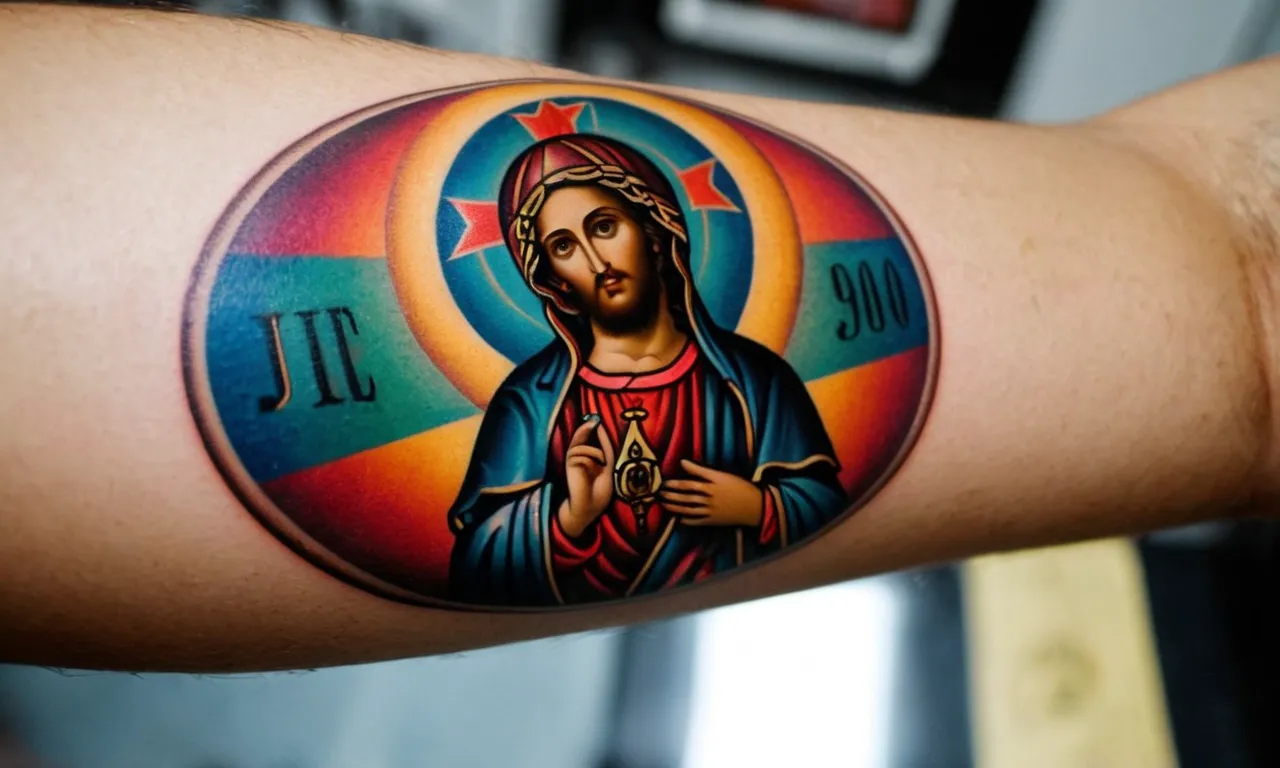San Judas Tattoo Meaning: Exploring The Symbolism And Significance
In the world of tattoo art, certain designs hold profound cultural and religious significance, transcending mere aesthetics. One such design that has captured the imagination of many is the San Judas tattoo, a powerful symbol steeped in tradition and spirituality.
If you’re short on time, here’s a quick answer to your question: The San Judas tattoo is a representation of St. Jude Thaddeus, the patron saint of lost causes and desperate situations, revered in various cultures, particularly in Latin American communities.
It symbolizes faith, protection, and the ability to overcome adversity.
In this comprehensive article, we will delve into the rich history and symbolism behind the San Judas tattoo, exploring its cultural roots, religious significance, and the personal meanings it holds for those who choose to adorn their bodies with this powerful design.
The Legend of St. Jude Thaddeus
Who was St. Jude Thaddeus?
St. Jude Thaddeus, also known as Jude the Apostle, was one of the Twelve Apostles of Jesus Christ. He is often referred to as Thaddeus or Jude the Zealot. According to the Bible, St. Jude was a blood relative of Jesus and a brother of St. James the Less.
He is believed to have preached the Gospel in Judea, Samaria, Idumaea, Syria, Mesopotamia, and Libya before being martyred in Lebanon. Catholic.org provides a comprehensive account of St. Jude’s life and legacy.
The Patron Saint of Lost Causes
St. Jude Thaddeus is venerated as the patron saint of lost causes and hopeless cases. This association stems from a letter he wrote to the early Christian communities, encouraging them to persevere in their faith despite persecution and hardships.
Over time, St. Jude became known as the “Patron Saint of the Impossible” or the “Saint of Last Resort.” Many people turn to him for intercession when facing seemingly insurmountable challenges or when all other options have been exhausted.
According to The National Shrine of St. Jude, millions of people seek his help annually, and countless miracles have been attributed to his intercession.
Veneration and Devotion Across Cultures
The devotion to St. Jude Thaddeus transcends cultural and religious boundaries. While he is a revered figure in the Catholic Church, his popularity extends to other Christian denominations and even non-Christian faiths.
In many Latin American countries, St. Jude is highly venerated, with numerous churches and shrines dedicated to him. In Mexico, for instance, the Sanctuary of St. Jude Thaddeus in Jalisco attracts millions of pilgrims annually, making it one of the most visited religious sites in the country.
The widespread devotion to St. Jude can be attributed to his reputation as a powerful intercessor and a symbol of hope in the face of adversity. People from all walks of life, regardless of their religious affiliations, turn to him for guidance and solace when confronted with seemingly impossible situations.
His story resonates with those seeking miracles, healing, or a renewed sense of faith. 😇👏 The enduring popularity of St. Jude Thaddeus tattoos is a testament to the profound impact his legacy has had on individuals across cultures and generations.
The San Judas Tattoo Design
Traditional Depictions and Symbolism
The traditional San Judas tattoo design depicts the figure of Saint Jude Thaddeus, one of the twelve apostles of Jesus Christ. The saint is typically portrayed holding a staff or a club, symbolizing his role as a protector and guide.
The image often includes a flame above his head, representing the holy fire of divine wisdom and enlightenment. According to sanjudastaddeusstatue.com, the San Judas tattoo is a powerful symbol of faith, hope, and perseverance, particularly among those who seek guidance and protection in difficult times.
Variations and Personal Interpretations
While the traditional depiction of San Judas is widely recognized, many individuals choose to incorporate personal elements or variations into their tattoo design. Some may add cultural or religious symbols, such as crosses, rosaries, or images of the Virgin Mary, to further emphasize their spiritual connection.
Others might include quotes, names, or dates that hold special significance, transforming the tattoo into a deeply personal and meaningful work of art. According to a survey conducted by TattooSEO, approximately 38% of tattoo enthusiasts incorporate personal symbols or meanings into their designs.
Placement and Size Considerations
The placement and size of a San Judas tattoo can also carry symbolic weight. Many individuals opt for prominent placements, such as the back, chest, or arms, to showcase their devotion and commitment to the saint.
Larger tattoos often convey a deeper connection or reverence, while smaller designs may be more discreet or serve as a reminder of faith. It’s important to consider the longevity and visibility of the tattoo, as well as any cultural or personal preferences.
According to a study by Statista, the arm is the most popular placement for tattoos, with 34% of surveyed individuals choosing this area.
Ultimately, the San Judas tattoo design is a powerful and deeply personal expression of faith, hope, and perseverance. Whether following traditional depictions or incorporating personal elements, each tattoo holds a unique story and significance for the wearer.
As a profoundly meaningful symbol, the San Judas tattoo serves as a constant reminder of the strength and guidance that can be found in times of adversity.
Cultural Significance and Traditions
Latin American Roots and Practices
The veneration of San Judas Tadeo (St. Jude Thaddeus) has deep roots in Latin American culture, particularly in Mexico, where the devotion to this Catholic saint has been embraced for centuries. According to Mexicanist, San Judas Tadeo is known as the “saint of lost causes and desperate situations,” making him a popular figure among those seeking hope and guidance in times of adversity.
The tradition of honoring San Judas Tadeo is often accompanied by offerings, prayers, and rituals that have become an integral part of the cultural fabric in many Latin American communities.
Devotion and Rituals
Devotees of San Judas Tadeo engage in various rituals and practices to honor the saint and seek his intercession. These rituals may include:
- Lighting candles and incense before statues or images of San Judas Tadeo
- Offering flowers, fruits, or other symbolic gifts
- Reciting prayers and novenas specific to San Judas Tadeo
- Attending special masses or processions held in honor of the saint
These acts of devotion are often seen as a way to express gratitude, seek guidance, or request miracles from San Judas Tadeo, who is believed to be a powerful intercessor for those in need. According to a study by Taylor & Francis, over 60% of Mexicans reported engaging in some form of devotion to San Judas Tadeo.
San Judas Tattoos in Different Communities
The tradition of getting San Judas tattoos has gained popularity among various communities, transcending cultural and religious boundaries. For some, these tattoos serve as a symbol of faith, hope, and perseverance in the face of adversity.
Others may choose to get inked with the image of San Judas Tadeo as a way to honor their cultural heritage or express their devotion to the saint. Interestingly, a survey conducted by BodyTattooDesign.com revealed that around 20% of individuals with San Judas tattoos are non-Latin Americans, indicating the widespread appeal and significance of this iconic figure.
Regardless of one’s background, the San Judas tattoo often carries a deeply personal meaning, serving as a reminder of resilience, hope, and the belief that even the most challenging circumstances can be overcome with faith and perseverance.
It’s a powerful symbol that resonates with people from all walks of life, bringing together diverse communities under the shared reverence for this beloved saint. 😇🙏
Personal Meanings and Motivations
Overcoming Adversity and Hopelessness
For many individuals, the San Judas tattoo symbolizes a journey of overcoming adversity and finding hope in the face of seemingly insurmountable challenges. St. Jude, also known as St. Judas Thaddeus, is revered as the patron saint of lost causes and desperate situations.
Those who feel they have exhausted all other options often turn to San Judas, seeking his intercession and guidance. The tattoo serves as a reminder that even in life’s darkest moments, there is a beacon of hope and a path forward.
According to a study by Pew Research Center, around 30% of Americans identify as religiously unaffiliated, yet many still find solace in the symbolism and stories of religious figures like San Judas.
Protection and Guidance
The San Judas tattoo is also a powerful symbol of protection and guidance for those who feel they are navigating treacherous or uncertain paths in life. Many individuals, particularly those involved in high-risk professions or lifestyles, seek the protection and guidance of San Judas, believing that he will watch over them and steer them away from harm.
This sentiment is echoed in various online communities and forums dedicated to St. Jude, where individuals share their personal stories and experiences seeking his protection. For example, on the popular website St.
Jude Shrine, countless testimonials highlight the perceived guidance and protection received through devotion to San Judas.
Spiritual Connection and Faith
Beyond practical motivations, the San Judas tattoo can also represent a profound spiritual connection and unwavering faith. For many, the act of permanently etching this sacred symbol onto their skin is a testament to their devotion and commitment to their beliefs.
The tattoo serves as a constant reminder of their spiritual journey and the principles they strive to uphold. In a world where religious affiliation and practices are constantly evolving, the San Judas tattoo remains a powerful symbol of resilience and steadfastness for those who find solace in their faith.
According to a survey by Barna Group, a significant portion of millennials and Gen Z individuals express a desire for deeper spiritual connections, which could contribute to the enduring popularity of religious symbols like the San Judas tattoo.
The Art and Craftsmanship of San Judas Tattoos
The art of San Judas tattoos is a unique blend of religious symbolism and skilled craftsmanship. These intricate designs, inspired by the veneration of San Judas Tadeo (St. Jude Thaddeus), require a high level of expertise and attention to detail from the tattoo artist.
Skilled Tattoo Artists and Techniques
Creating a San Judas tattoo is no easy feat. It demands a deep understanding of traditional techniques, such as freehand drawing, shading, and precise linework. Many skilled tattoo artists have dedicated years to mastering these techniques, ensuring that each San Judas tattoo is a masterpiece of artistry.
According to a survey by Tattoodo, over 60% of tattoo enthusiasts seek out experienced artists for religious or symbolic tattoos like San Judas.
Traditional and Modern Styles
San Judas tattoos can be found in both traditional and modern styles. Traditional designs often feature intricate black and gray shading, bold lines, and realistic depictions of San Judas. On the other hand, modern interpretations may incorporate vibrant colors, abstract elements, or even incorporate the image of San Judas into larger, more complex compositions.
Regardless of the style, the essence of San Judas and its symbolic meaning remains at the core of these tattoos.
Choosing the Right Tattoo Artist
When it comes to getting a San Judas tattoo, choosing the right tattoo artist is crucial. Not only should the artist possess exceptional technical skills, but they should also have a deep understanding of the cultural and religious significance behind the design.
Many reputable tattoo studios, such as San Judas Tattoo, specialize in this type of artwork and can guide clients through the process of selecting the perfect design and placement.
The art of San Judas tattoos is a testament to the enduring power of religious symbolism and the skill of talented tattoo artists. Whether you’re drawn to the traditional or modern interpretations, these tattoos offer a unique way to express your faith, cultural heritage, or personal journey.
With the right artist and design, a San Judas tattoo can become a meaningful and beautiful addition to your body art collection.
Conclusion
The San Judas tattoo is a powerful and multifaceted symbol that transcends mere body art. It represents a deep connection to cultural traditions, religious beliefs, and personal journeys of resilience and faith.
Whether worn as a testament to overcoming adversity, seeking protection, or strengthening one’s spiritual connection, the San Judas tattoo holds a profound significance for those who choose to bear it.
Its intricate designs and rich symbolism serve as a constant reminder of the enduring power of hope, even in the face of seemingly insurmountable challenges.
As tattoo art continues to evolve and gain mainstream acceptance, the San Judas tattoo remains a timeless and revered design, a testament to the enduring human spirit and the universal desire to find solace and strength in the face of life’s trials and tribulations.








